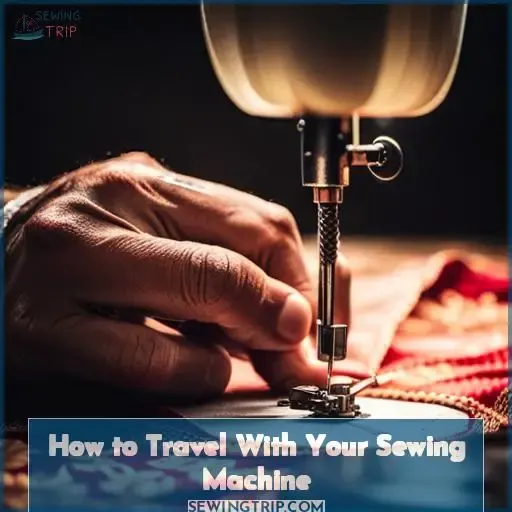This site is supported by our readers. We may earn a commission, at no cost to you, if you purchase through links.
 Imagine the freedom of taking your sewing machine with you wherever you go, allowing you to create and design on the move. The best part? You can actually carry your sewing machine as a carry-on item during train or airplane travel.
Imagine the freedom of taking your sewing machine with you wherever you go, allowing you to create and design on the move. The best part? You can actually carry your sewing machine as a carry-on item during train or airplane travel.
But before embarking on this liberating journey, it’s crucial to check airline regulations and restrictions that may vary for different providers. In this article, we’ll guide you through essential tips and tricks for traveling with your beloved sewing machine safely and hassle-free.
Table Of Contents
Key Takeaways
- Select a durable container with protective padding for sewing machine travel.
- Prioritize organization with zippered compartments and open sections.
- Familiarize yourself with airline regulations and pack accordingly.
- Remove needles and secure accessories separately for compliance and safety.
The Container
Choose a durable container that can safely store your sewing machine while traveling.
When it comes to transporting your sewing machine, you want to ensure it’s well-protected and secure. Look for containers that offer durable protection against any bumps or jolts during travel.
Consider options such as fabric cases, art supply boxes, or even fishing tackle boxes—they are all excellent choices for keeping your sewing machine safe and sound.
Additionally, prioritize compact organization by selecting a container with zippered compartments and open sections for easy access to specific items like scissors, pins, and needles.
Don’t forget about style! There are plenty of stylish containers available that not only provide the necessary protection but also add a touch of flair to your travel ensemble.
And if you’re feeling crafty? DIY options allow you to customize both the security features and aesthetics of your container according to your preferences—truly giving you mastery over every aspect of packing a sewing machine for travel.
Sewing Machine Travel Bag Features
When it comes to traveling with your sewing machine, having a travel-friendly sewing machine case is essential.
Look for features like sturdy construction, padded interior, and compartments for organizing accessories.
Additionally, don’t forget to pack the essentials such as extra bobbins and presser feet specific to your projects.
Lastly, familiarize yourself with airline regulations and restrictions regarding carrying sewing machines onboard or in checked baggage to avoid any surprises at the airport.
Travel-friendly sewing machine cases
When traveling with your sewing machine, consider investing in a travel-friendly sewing machine case for added convenience and protection.
Look for durability factors to ensure the case can withstand the rigors of travel.
Compact designs are essential for easy transportation and storage.
Customization options allow you to organize your sewing supplies efficiently.
Security features such as locks or reinforced corners provide peace of mind during transit.
Don’t forget to check user reviews before making a purchase decision!
Packing essentials for sewing machine travel
To ensure a smooth and hassle-free journey with your sewing machine, pack the essential items in a travel-friendly sewing machine case.
Look for cases that provide protective padding to keep your machine safe during transit.
Make sure there are secure compartments to store needle security and other attachments.
Opt for compact containers that meet airline regulations, so you can easily inquire about weight limits from your travel provider.
Prepare your machine beforehand by removing needles and securing them separately.
Airline regulations and restrictions
Before we dive into the features of a sewing machine travel bag, let’s address the airline regulations and restrictions that you need to be aware of when traveling with your sewing machine.
It’s important to ensure security compliance and follow travel-friendly cases guidelines. Be mindful of rules regarding needles and accessories, as well as proper machine preparation for safe transport.
Additionally, personal experiences can provide valuable insights into navigating airline regulations and packing tips for hassle-free travels with your beloved sewing machine.
What to Look for in a Portable Sewing Machine
Now that you have learned about the essential features of a sewing machine travel bag, let’s delve into what to look for in a portable sewing machine.
When choosing a portable sewing machine, there are several factors to consider that will ensure your freedom and mastery while on the go.
- Compact Options: Look for machines specifically designed with portability in mind. These machines are often lightweight and compact, making them easy to carry and store during your travels.
- Stitch Variety: Ensure that the portable sewing machine offers a variety of stitch options suitable for different projects. This versatility will allow you to tackle various types of fabrics and designs while maintaining creative control.
- Durability Factors: Consider the durability of the materials used in constructing the machine as well as its overall build quality. Opting for sturdy construction ensures longevity even when subjected to frequent transportation or handling.
By keeping these considerations in mind – compactness, stitch variety, durability – you can confidently choose a portable sewing machine that meets all your needs while providing liberation and power wherever you go!
Frequently Asked Questions (FAQs)
Are there any specific regulations or restrictions for carrying sewing machines on airplanes?
Contact the airline to inquire about any regulations or restrictions for carrying sewing machines as carry-on items.
Be prepared to comply with guidelines regarding accessories and security procedures if inspected.
Consider options like protective cases to ease transport.
How should I prepare my sewing machine for travel?
Remove the needle and accessories to comply with guidelines.
Securely store sharp objects in checked luggage.
Consider protective cases or padding around the machine.
Verify carry-on size and weight restrictions.
Ensure proper preparation to ease transport worries.
What type of suitcase should I use to transport my sewing machine?
When transporting your sewing machine,
opt for a soft-sided carry-on suitcase that provides a snug yet flexible fit. This allows you to securely pad the machine while meeting airline size requirements.
Prioritize protection and portability to simplify your sewing travels.
How can I protect my sewing machine from damage during travel?
Carefully pad your machine inside a suitcase using quilts or soft materials.
Avoid shifting by securing it tightly.
Inspect for signs of damage whenever handling your luggage.
Travel safely knowing proper precautions prevent sewing machine harm.
What are some personal experiences or tips from others who have traveled with sewing machines?
When traveling, soft-sided suitcases allow flexibility fitting machines. Quilts pad nicely.
Expect inspections; anticipate answering questions.
With preparation, your machine will arrive safely to inspire creativity anywhere.
Conclusion
To ensure a hassle-free and liberating sewing experience while traveling, it’s important to carefully consider the container and bag you use to carry your sewing machine.
Look for travel-friendly sewing machine cases that provide adequate protection and storage space for your machine and essential accessories.
Familiarize yourself with airline regulations and restrictions to avoid any issues during your journey.
And when choosing a portable sewing machine, prioritize features that make it easy to transport and use on the go.
With these tips, you can confidently carry your sewing machine wherever you go. Happy sewing!









